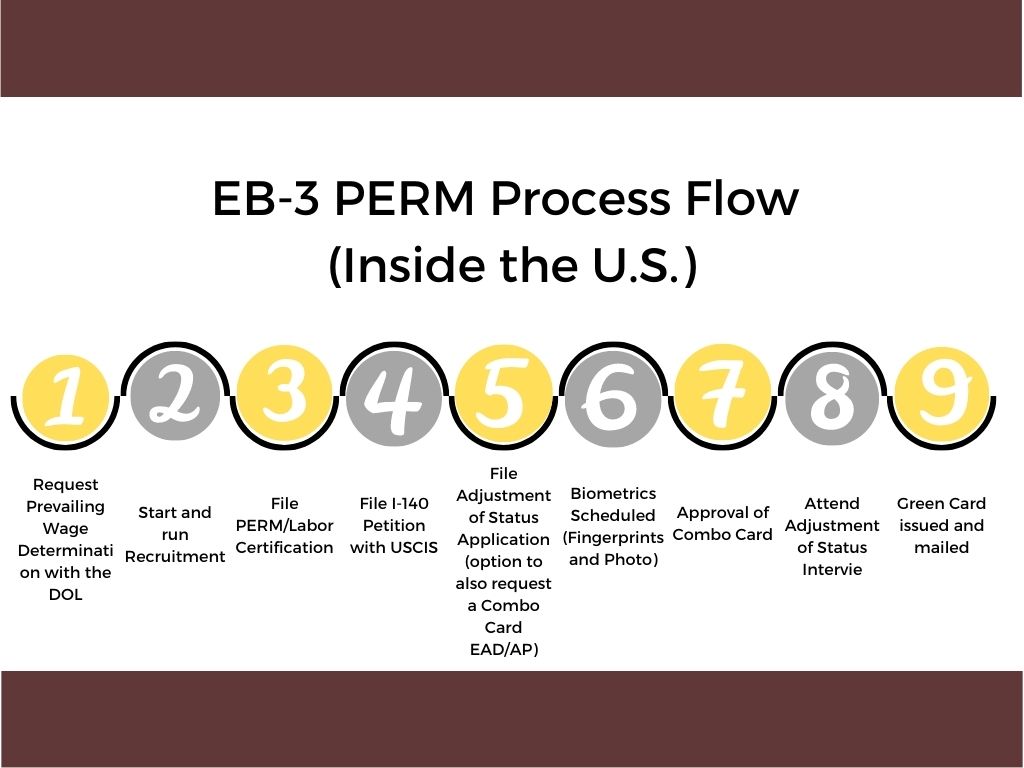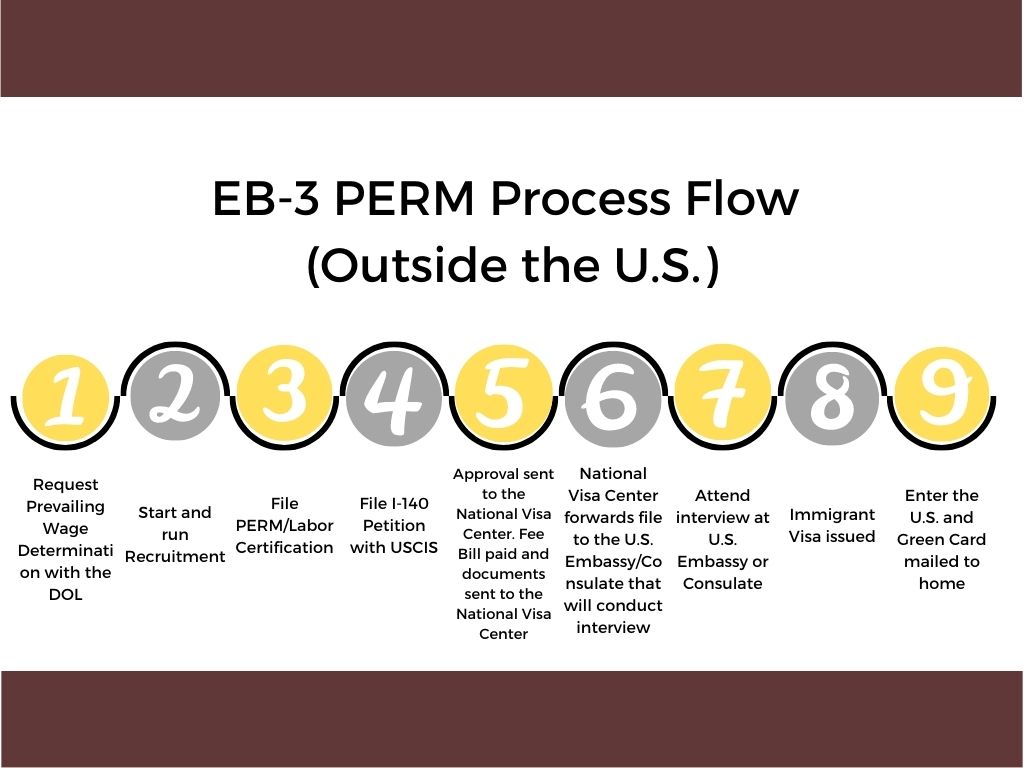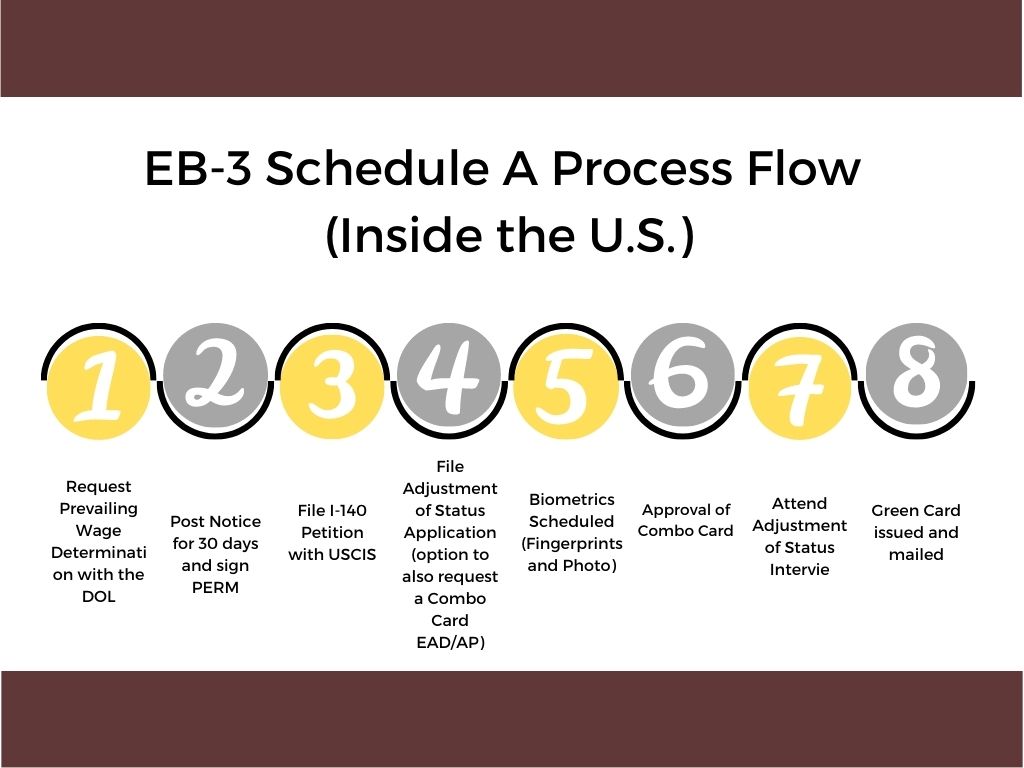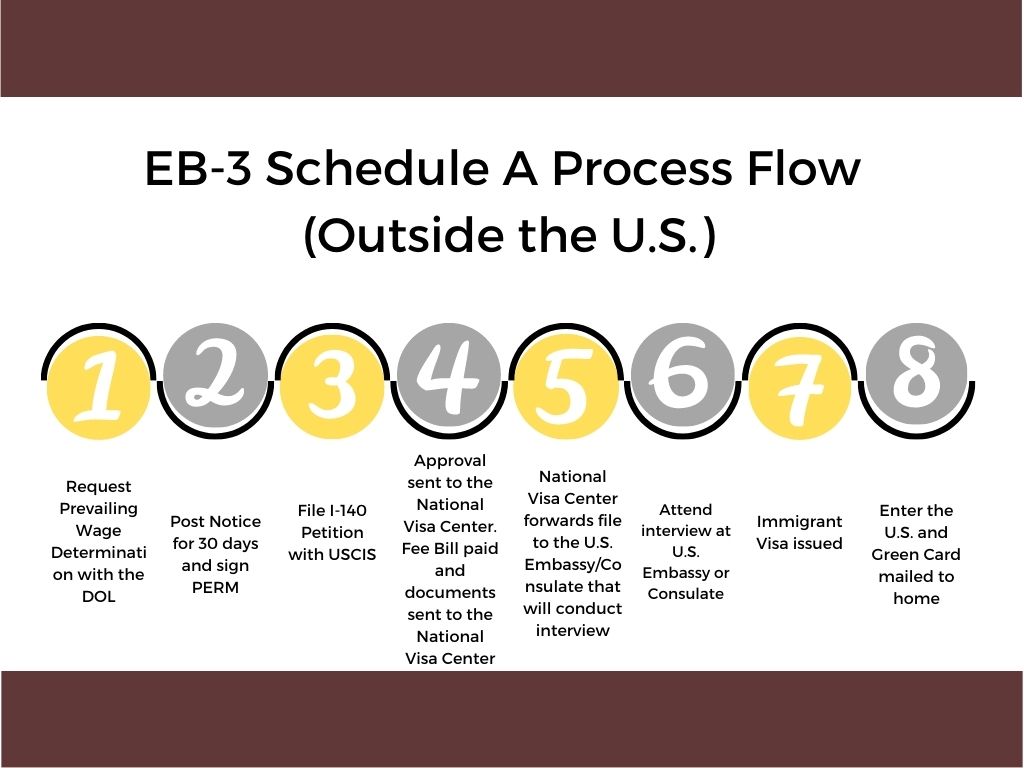EB-3 Skilled Workers / Professionals / Unskilled Workers (Other Workers) Green Card (including Schedule A Nurses and Physical Therapists)
 The EB-3 immigrant visa category provides lawful permanent residence to professionals, skilled workers and unskilled workers with a permanent offer of employment in the US. This category requires a job offer and a labor certification issued by the Department of Labor (DOL). The labor certification process exists to protect U.S. workers and the U.S. labor market by ensuring that foreign workers seeking immigrant visa classifications are not displacing qualified U.S. workers.
The EB-3 immigrant visa category provides lawful permanent residence to professionals, skilled workers and unskilled workers with a permanent offer of employment in the US. This category requires a job offer and a labor certification issued by the Department of Labor (DOL). The labor certification process exists to protect U.S. workers and the U.S. labor market by ensuring that foreign workers seeking immigrant visa classifications are not displacing qualified U.S. workers.
To qualify for an EB-3 Green Card, the foreign national must have a permanent, full time job offer from a U.S. employer for which qualified workers are not available in the United States.
- Professionals must possess a baccalaureate degree, or degree equivalent, that is required for entry into their occupation.
- Skilled Workers must be able to demonstrate at least 2 years of job experience or training.
- Other Workers must be undertaking unskilled labor that requires less than 2 years of training or experience.
The process for obtaining an EB-3 green card is composed of three phases: (1) the labor certification; (2) the visa petition; and (3) the application for permanent residence.
Each of these phases are explained in the next sections.
Labor Certification Application
A “labor certification” is a certification by the U.S. Department of Labor (DOL) that a shortage of qualified U.S. workers exists to fill a job to be offered to a foreign national and that the foreign national will be paid the “prevailing wage.” One of the most important factors in the ultimate success of a labor certification is a correct determination of the minimum requirements needed to perform the job.
2005, DOL drastically changed the way it processes labor certification cases. The primary difference between the new process (referred to as PERM) and the old process is how recruitment-related documentation is handled. Previously, supporting documentation, such as newspaper ads and other recruitment efforts, justification of the job requirements, prevailing wage determinations, etc., were submitted when the labor certification application was filed. Under PERM, while the same documentation must be prepared or assembled, it is kept by the employer and only submitted if and when requested by DOL. The employer is required to retain this documentation for five years.
Under the previous regulations, there were two types of labor certifications: Reduction in Recruitment (RIR) (also known as “fast-track,” since these types of cases were given priority handling), and traditional or non–Reduction in Recruitment (non-RIR) cases. These two classifications have been done away with. However, occupations are now classified as “professional” or “nonprofessional” and each classification has different recruitment requirements. Both classifications require two Sunday newspaper ads and a 30-day job posting with the State Workforce Agency (SWA). For professional positions, the employer must comply with at least three out of 10 listed steps: (1) job fairs; (2) employer’s website; (3) job search website other than the employer’s; (4) on-campus recruiting; (5) trade or professional organizations; (6) private employment firms; (7) employee referral program with incentives; (8) campus placement offices; (9) local and ethnic newspapers; and (10) radio or television advertisements. If the occupation is classified as a “profession” and the employer fails to do these additional steps, the labor certification application will be denied.
Applying for a labor certification does not bind the employer legally. Finally, the labor certification application may be withdrawn by the employer at any time.
The Visa Petition: EB-3 Labor Certification
The purpose of the visa petition is to prove to USCIS that: (1) the offered job has been certified by DOL; (2) the foreign national meets all of the requirements listed on the labor certification; and (3) the sponsoring employer has sufficient resources to pay the offered salary. This step will also establish the immigrant preference classification.
During the visa petition phase, it will be necessary to submit documentation from the employer demonstrating its ability to pay the offered salary. This will usually be a federal tax return, or for larger companies, a letter or annual report. In addition, it is at this step that the foreign national will be submitting documentation regarding proof of his/her education and experience. Therefore, at that time, diplomas, transcripts, and letters from previous employers, are necessary.
By the time the visa petition is filed, the foreign national must decide whether he/she will apply for permanent residence here in the United States or at a U.S. consulate or embassy abroad.
The Visa Petition: EB-3 Schedule A Nurses and Physical Therapists
Schedule A is a list of pre-certified occupations codified in 20 CFR 656.10 and 20 CFR 656.22 for which the Secretary of the Department of Labor previously has determined that there are not sufficient U.S. workers who are able, willing, qualified and available and that the wages and working conditions of U.S. workers similarly employed will not be adversely affected by the employment of foreign nationals in such occupations. The IMMACT ’90 amendments to the Immigration and Nationality Act (Act) gave separate visa classifications to some groups that previously were included in Schedule A. As a result, DOL eliminated these groups from Schedule A, leaving only Group I, registered nurses and physical therapists, and Group II, foreign nationals of exceptional ability.
Therefor a regular Labor Certification process is not required but an offer of employment from a U.S. employer is still required.
On December 27, 2004, DOL published a final rule, Labor Certification for the Permanent Employment of Foreign nationals in the United States; Implementation of New System, which significantly restructures the permanent labor certification process. This final rule deletes the current language of 20 CFR part 656 and replaces the part in its entirety with new regulatory text, effective on March 28, 2005.
On March 28, 2005, DOL effectively amended its regulations governing the filing and processing of labor certification applications for the permanent employment of foreign nationals in the United States to implement a new system for filing and processing such applications. Many of the evidentiary requirements relating to Schedule A petitions have been changed as of that date.
Pursuant to new 20 CFR 656.10 and 20 CFR 656.15, in order to apply for certification under Schedule A for petitions filed on or after March 28, 2005, the petitioner should complete and submit:
- The Form I-140 petition, with appropriate filing fees,
- An uncertified Form ETA-9089, in duplicate, signed in the original by an authorized official of the petitioning organization, the foreign national, and the representative, if any,
- A Wage Determination issued by the State Workforce Agency (SWA) having jurisdiction over the proposed area where the job opportunity exists,
- A copy of the posted notice, and
- Copies of any and all in-house media, whether electronic or printed, in accordance with the normal procedures used for the recruitment of similar positions to the position specified in the Form 9089 in the employer's organization.
- For petitions filed for registered nurses, a full unrestricted permanent license to practice nursing in the state of intended employment, CGFNS certificate issued by the Commission on Graduates of Foreign Nursing Schools or evidence that the foreign national has passed the National Council Licensure Examination for Registered Nurses (NCLEX-RN), administered by the National Council of State Boards of Nursing.
- For petitions filed for physical therapists, a permanent license to practice in the state of intended employment or, a letter or statement, signed by an authorized state physical therapy licensing official, stating that the beneficiary is qualified to take that state’s written licensing examination for physical therapists.
Healthcare professionals also need to obtain a VisaScreen® before entering the U.S. to work, except Physicians.
The VisaScreen®: Visa Credentials Assessment Service is a comprehensive screening program for health care professionals who are not U.S. citizens and are seeking an occupational visa to work in the United States. Health care professionals need to complete the screening program before they can receive either a permanent or temporary occupational visa, including Trade NAFTA (USCMA) status.
What does the VisaScreen® Program include?
- An assessment of an foreign national’s education to ensure that it is comparable to that of a U.S. graduate in the same profession
- A verification that all professional health care licenses that an foreign national ever held are valid and without restrictions
- An English language proficiency examination
- For registered nurses only, a verification that the nurse has passed either the CGFNS Qualifying Exam®, NCLEX-RN® or for select years and provinces its predecessor, the State Board Test Pool Examination (SBTPE).
Foreign nationals who successfully complete VisaScreen® receive an official Certificate for the VisaScreen®: Visa Credentials Assessment Service, which satisfies the United States Federal screening requirements.
Application for Lawful Permanent Residence
Presuming there is no backlog for an immigrant visa for the foreign national’s country of chargeability and preference category as determined by the labor certification filing date or the filing of the visa petition (i.e., priority date), if the foreign national is in the United States on a temporary nonimmigrant visa, or if he or she otherwise qualifies by regulation, the foreign national and his or her family may be eligible to apply for adjustment of status to lawful permanent resident with the regional service center of USCIS. If the foreign national is not in the United States, or does not qualify for adjustment of status, then the foreign national and his or her family must apply for immigrant visas at the appropriate U.S. consulate in his or her home country or country of residence. If permanent residence is applied for in the United States, it is called “adjustment of status” processing. If applied for outside the United States, it is called applying for an immigrant visa.” The result of either is the same: permanent residence.
As part of the ADJUSTMENT OF STATUS Application process, a foreign national may also apply for an employment authorization document (EAD) and advance parole (AP). A foreign national is not required to apply for an EAD or AP at the time he/she files his/her ADJUSTMENT OF STATUS Application or while his/her ADJUSTMENT OF STATUS Application is pending. It can take U.S. Citizenship and Immigration Services (USCIS, legacy Immigration and Naturalization Service) several months to approve a foreign national’s ADJUSTMENT OF STATUS Application. If a foreign national’s circumstances change during that time period, having the approved EAD and AP available will provide maximum flexibility even if for now a foreign national plan to continue to maintain his/her nonimmigrant status (such as H-1B, L-1, or O-1 status).
What is an EAD?
A foreign national can obtain an EAD card by filing an EAD Application at the same time he/she files his/her ADJUSTMENT OF STATUS Application, or after the ADJUSTMENT OF STATUS Application is filed. Once approved, the EAD card allows its holder to work for any employer while the card is valid. By contrast, a foreign national’s nonimmigrant status (H-1B, O-1, L-1, etc.) allow him/her to work only for the employer who filed the nonimmigrant petition. Once a foreign national has an EAD in hand, he/she may legally work for any employer (but remember that even with an EAD, a foreign national must have the intent to work for the sponsoring employer, in case of employment-based permanent residence, at the time his/her ADJUSTMENT OF STATUS Application is approved). EADs are valid for up to one year at a time. Spouses and dependent children may also obtain EADs, if desired.
What is an Advance Parole?
A foreign national can obtain AP by filing an AP Application at the same time he/she files his/her ADJUSTMENT OF STATUS Application, or after the ADJUSTMENT OF STATUS Application is filed. Once approved, AP allows a foreign national to leave the United States and re-enter without having a valid nonimmigrant visa stamp in his/her passport. Unless a foreign national is maintaining H-1B or L-1 status, after his/her ADJUSTMENT OF STATUS Application is filed, a foreign national must obtain AP before leaving the United States. For example, if a foreign national has O-1 status and he/she files an ADJUSTMENT OF STATUS Application and then later a he/she leaves the United States without AP, his/her ADJUSTMENT OF STATUS Application will be considered by USCIS to have been “abandoned” and will be denied. This would cause great delay and expense because it could take weeks or months to get a foreign national back to the United States in new O-1 status, and then a new ADJUSTMENT OF STATUS Application package would have to be filed all over again. Traveling with AP prevents such problems from occurring. AP is valid for multiple entries during the validity of the document.
At the lawful permanent residence application stage, the USCIS (or consular office) will ask whether the foreign national has: (1) been a member of the Communist Party, terrorist groups, or similar organizations; (2) been arrested or convicted of any crimes; (3) ever received public assistance, (4) lied to obtain a visa, (5) worked in the United States without permission, or (6) overstayed his/her legal status, etc. We will go into more detail about these factors later.
In general, employment-based and family-based adjustment of status cases are subject to interviews with the local USCIS district office. Individuals who undergo consular processing of employment-based or family-based cases are also required to attend an interview.
At the end of this step, the foreign national will be granted permanent residence and issued a “green card.”




